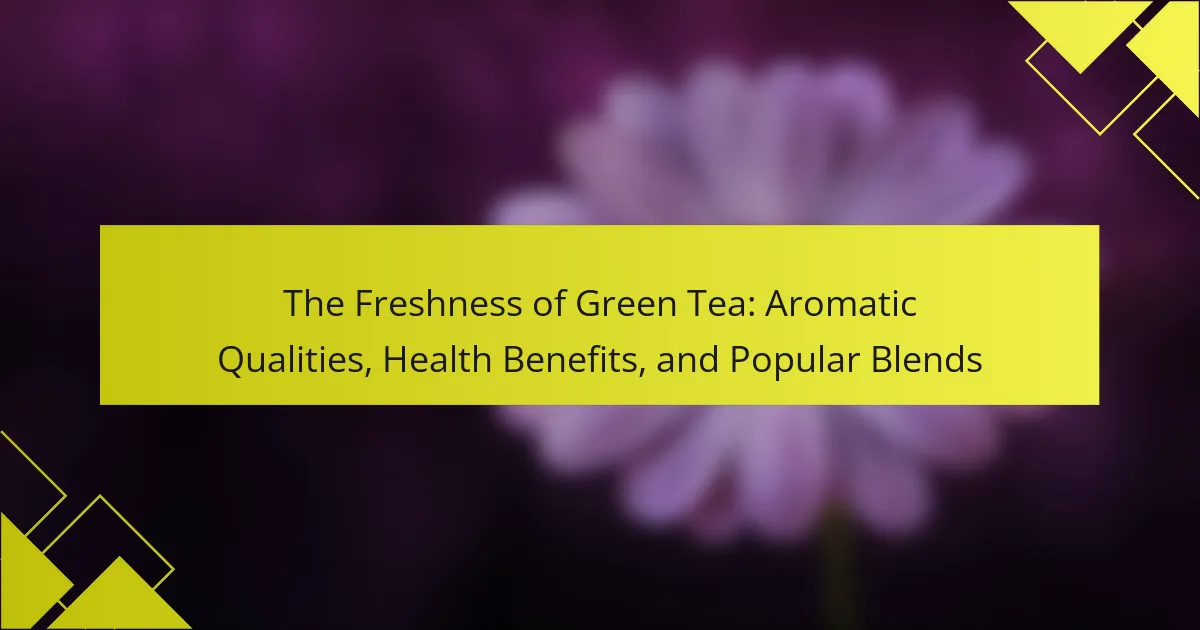
What is Vanilla and Why is it Important?
Vanilla is a flavoring derived from the pods of the vanilla orchid. It is important due to its widespread use in culinary applications. Vanilla enhances the flavor of desserts, beverages, and savory dishes. The global vanilla market was valued at approximately $1.5 billion in 2020. Madagascar is the largest producer, supplying about 80% of the world’s vanilla. Vanilla contains vanillin, which is responsible for its distinct aroma and taste. It also has antioxidant properties, contributing to its health benefits. The demand for natural vanilla has increased as consumers seek organic and authentic flavors.
What are the key aromatic qualities of Vanilla?
Vanilla possesses rich, sweet, and creamy aromatic qualities. These characteristics are primarily due to the presence of vanillin, the main compound responsible for its distinctive scent. The aroma of vanilla is often described as warm and inviting. Additionally, it has subtle floral and woody undertones that enhance its complexity. Vanilla’s fragrance is widely used in perfumes and culinary applications. Studies show that natural vanilla extract contains over 200 different compounds contributing to its aroma. This multifaceted scent profile makes vanilla a favorite in both desserts and savory dishes.
How do the aromatic compounds in Vanilla contribute to its scent?
The aromatic compounds in vanilla primarily contribute to its scent through a complex mixture of volatile organic compounds. These compounds include vanillin, which is the most significant and recognizable component. Vanillin has a sweet, creamy aroma that is often associated with vanilla flavor.
In addition to vanillin, other compounds such as p-hydroxybenzaldehyde and guaiacol also play a role in creating the overall scent profile. These compounds add depth and nuance, enhancing the sweet and warm characteristics of vanilla.
The presence of these aromatic compounds can vary based on the source and method of extraction. For instance, natural vanilla extract has a richer scent due to the variety of compounds present, compared to synthetic vanilla flavoring.
Research has shown that the combination of these compounds creates a unique olfactory experience that is widely appreciated in culinary applications. The complexity of the aromatic profile is what makes vanilla a popular choice in both sweet and savory dishes.
What role does the curing process play in developing Vanilla’s aroma?
The curing process is essential in developing vanilla’s aroma. This process involves blanching, sweating, and drying the vanilla beans. Blanching kills enzymes that can degrade flavor. Sweating allows the beans to ferment, which enhances their aromatic compounds. During drying, moisture is removed, concentrating the flavors. The curing process typically lasts several months. It transforms the beans from green to dark brown, intensifying their scent. Studies show that proper curing can increase vanillin content, the primary aromatic compound in vanilla.
How has Vanilla’s popularity evolved over time?
Vanilla’s popularity has significantly evolved from ancient times to the present. Initially, vanilla was highly valued by the Totonac people of Mexico, who used it in rituals and as a flavoring. The Spanish conquest in the 16th century introduced vanilla to Europe, where it gained popularity among the elite. By the 19th century, vanilla became widely available, thanks to advancements in cultivation and extraction methods. The introduction of synthetic vanilla in the early 20th century further boosted its accessibility and use in various products. Today, vanilla remains one of the most popular flavors globally, utilized in desserts, beverages, and perfumes. According to market research, the global vanilla market is projected to grow significantly, reflecting its enduring appeal.
What historical significance does Vanilla hold in various cultures?
Vanilla has significant historical importance in various cultures, particularly in Mesoamerica. The Totonac people of present-day Mexico were among the first to cultivate vanilla, using it in rituals and as a flavoring for beverages. They believed vanilla was a gift from the gods. Later, the Aztecs adopted vanilla, incorporating it into their chocolate drinks, enhancing the beverage’s flavor and value.
Vanilla was introduced to Europe in the 16th century by Spanish explorers. It became a luxury item among European aristocrats. The cultivation of vanilla expanded globally, particularly in Madagascar, which now produces the majority of the world’s supply.
The historical significance of vanilla is also evident in its role in trade. It was highly sought after, leading to the establishment of trade routes. Vanilla’s cultural relevance continues today, symbolizing luxury and indulgence in culinary traditions worldwide.
How has the demand for Vanilla changed in recent years?
The demand for vanilla has significantly increased in recent years. This rise is driven by a growing consumer preference for natural flavors over artificial ones. According to a report by Grand View Research, the global vanilla market size was valued at approximately $1.3 billion in 2020. It is projected to grow at a compound annual growth rate (CAGR) of 5.5% from 2021 to 2028. Additionally, the popularity of vanilla in the food and beverage industry has surged, particularly in premium products. The trend towards organic and sustainably sourced ingredients has also contributed to this increase.
What are the primary culinary uses of Vanilla?
Vanilla is primarily used as a flavoring agent in various culinary applications. It enhances desserts such as ice cream, cakes, and pastries. Vanilla is also commonly added to beverages, including coffee and cocktails. In savory dishes, it can complement sauces and marinades. Additionally, vanilla is used in making chocolates and confections. Its aromatic qualities make it a popular ingredient in baking and cooking. Studies show that vanilla’s flavor compounds, like vanillin, contribute significantly to its appeal in culinary uses.
In what forms can Vanilla be used in cooking and baking?
Vanilla can be used in several forms in cooking and baking. The most common forms are vanilla extract, vanilla bean, and vanilla powder. Vanilla extract is a liquid made by soaking vanilla beans in alcohol. It is widely used for flavoring desserts and baked goods. Vanilla beans are whole pods that contain tiny seeds. They provide a rich, intense flavor and can be used in recipes where the appearance of the seeds is desirable. Vanilla powder is made from ground dried vanilla beans. It is a convenient alternative to extract and can be used in dry mixes. Each form offers a distinct flavor profile and varying intensity.
How does Vanilla enhance the flavor profiles of different dishes?
Vanilla enhances the flavor profiles of different dishes by adding depth and complexity. Its rich, sweet aroma complements both sweet and savory foods. In desserts, vanilla elevates flavors in cakes, ice creams, and pastries. It balances sweetness and adds a warm undertone. In savory dishes, vanilla can enhance sauces and marinades, providing a unique flavor contrast. The presence of vanillin, the main flavor compound, contributes to its aromatic quality. Studies show that vanilla can enhance the perception of sweetness without additional sugar. This versatility makes vanilla a popular choice in diverse culinary applications.

What are the Different Types of Vanilla?
There are several different types of vanilla, primarily categorized by their origin and flavor profiles. The most common types include Bourbon vanilla, which is grown in Madagascar and has a rich, creamy flavor. Mexican vanilla is known for its bold and spicy notes, often used in traditional Mexican desserts. Tahitian vanilla, originating from French Polynesia, has a floral and fruity aroma, making it unique among vanillas. Additionally, there is Indonesian vanilla, which has a more smoky and earthy flavor. Each type of vanilla offers distinct qualities that can enhance various culinary applications.
What are the main varieties of Vanilla and their characteristics?
The main varieties of vanilla include Bourbon, Tahitian, and Mexican vanilla. Bourbon vanilla is known for its creamy, sweet flavor and is primarily grown in Madagascar. It has a higher vanillin content, contributing to its popularity in culinary uses. Tahitian vanilla has floral and fruity notes, making it distinct from other varieties. It is primarily cultivated in French Polynesia and is often used in desserts. Mexican vanilla has a rich, spicy flavor profile and is traditionally used in Mexican cuisine. It is sourced from Mexico and is known for its unique taste due to the specific conditions of its growth. Each variety offers unique characteristics that enhance different culinary applications.
How does Madagascar Vanilla differ from Tahitian Vanilla?
Madagascar Vanilla differs from Tahitian Vanilla primarily in flavor profile and growing conditions. Madagascar Vanilla, known as Bourbon vanilla, has a rich, creamy, and sweet flavor. It is grown in Madagascar’s humid climate, which contributes to its distinctive taste. In contrast, Tahitian Vanilla has a floral, fruity, and slightly spicy flavor profile. This variety is cultivated in the warmer, drier climate of Tahiti. Madagascar Vanilla typically has a higher vanillin content, around 2-3%, compared to Tahitian Vanilla’s lower levels. The beans of Madagascar Vanilla are also longer and thicker than those of Tahitian Vanilla. These differences in flavor and characteristics make each variety suitable for different culinary applications.
What unique attributes does Mexican Vanilla possess?
Mexican Vanilla possesses a rich, complex flavor profile that is distinct from other vanillas. It has a sweet, creamy, and slightly spicy taste. This unique flavor is due to the presence of specific compounds such as vanillin and other aromatic compounds. Mexican Vanilla is also known for its deep, dark color, which enhances its visual appeal in culinary applications. Additionally, it is often derived from the species Vanilla planifolia, which is native to Mexico. The traditional extraction process involves aging the beans, which enhances their flavor complexity. This aging process is not commonly found in other vanilla varieties. Overall, the unique attributes of Mexican Vanilla make it a sought-after ingredient in gourmet cooking and baking.
How can you identify high-quality Vanilla?
High-quality vanilla can be identified by its aroma, appearance, and flavor profile. Genuine vanilla has a rich, sweet, and creamy scent. The beans should be dark brown to black and slightly oily. They should be flexible and not brittle, indicating freshness. When you taste it, high-quality vanilla has a complex flavor with hints of sweetness and floral notes. Additionally, the presence of vanillin crystals on the surface can indicate quality. Authentic vanilla typically comes from specific regions, such as Madagascar or Tahiti, known for premium production.
What indicators signal the freshness of Vanilla beans?
Fresh vanilla beans are indicated by their moistness, flexibility, and strong aroma. Fresh beans should feel plump and oily to the touch. They should not be dry or brittle, as this suggests age. A strong, sweet, and rich vanilla scent is a key indicator of freshness. Fresh beans often have visible seeds inside, which can be seen when split open. The color of fresh vanilla beans typically ranges from dark brown to black. Beans that appear gray or have a dull finish may be past their prime. The presence of a glossy sheen on the surface signifies quality and freshness.
How do price and sourcing affect the quality of Vanilla products?
Price and sourcing significantly impact the quality of vanilla products. Higher prices often reflect better quality due to factors like cultivation methods and sourcing locations. Premium vanilla is typically sourced from regions with ideal growing conditions, such as Madagascar. These regions produce beans with complex flavor profiles and higher vanillin content. In contrast, lower-priced vanilla may come from less ideal sources or be synthetic. Synthetic vanilla lacks the depth of flavor found in natural products. Quality assessments often show that gourmet vanilla beans command higher prices because of their superior aroma and taste. Thus, consumers can often gauge quality based on price and sourcing information.

What are the Best Practices for Using Vanilla in Cooking?
Use pure vanilla extract for the best flavor in cooking. Pure vanilla extract contains real vanilla beans, providing a rich aroma and taste. Avoid imitation vanilla, as it lacks the depth of flavor found in pure extract. Measure carefully; typically, one teaspoon of vanilla extract is sufficient for most recipes. Add vanilla at the right time; for baked goods, incorporate it with wet ingredients. For sauces, add vanilla towards the end of cooking to preserve its flavor. Store vanilla extract in a cool, dark place to maintain its potency. Use vanilla beans for an intense flavor; split the bean and scrape the seeds into your dish.
How should Vanilla be stored to maintain its quality?
Vanilla should be stored in a cool, dark place to maintain its quality. Exposure to light and heat can degrade its flavor and aroma. It is best to keep vanilla beans in an airtight container. This prevents moisture loss and protects against contamination. Vanilla extract should also be stored similarly, away from direct sunlight. Proper storage can extend the shelf life of vanilla for several years. Research indicates that optimal conditions preserve the essential oils responsible for vanilla’s distinctive flavor.
What are the best methods for extracting flavor from Vanilla beans?
The best methods for extracting flavor from vanilla beans are maceration, infusion, and alcohol extraction. Maceration involves slicing the beans and soaking them in a liquid, allowing the flavors to infuse. Infusion can be done by adding vanilla beans directly to warm liquids like milk or cream. Alcohol extraction is commonly done by steeping the beans in vodka or another spirit. This method is popular for making vanilla extract. Each method effectively captures the aromatic compounds in the beans. Studies show that alcohol extraction yields a more concentrated flavor profile.
How can you substitute Vanilla in recipes if needed?
You can substitute vanilla in recipes with several alternatives. Common substitutes include almond extract, maple syrup, and honey. Use half the amount of almond extract as a replacement. Maple syrup can be used in equal amounts to vanilla. Honey also works well, but may add sweetness. For a non-liquid option, consider vanilla powder. Vanilla bean paste is another suitable alternative, used in equal amounts. Each substitute will impart a different flavor profile, so choose based on the desired taste.
What tips can enhance your culinary experience with Vanilla?
To enhance your culinary experience with vanilla, use pure vanilla extract instead of imitation. Pure vanilla extract contains real vanilla beans, providing a richer flavor. When baking, add vanilla at the beginning for depth. For beverages, infuse vanilla pods in cream or milk for a subtle taste. Pair vanilla with complementary flavors like chocolate, citrus, or spices. Use vanilla in savory dishes, such as sauces or marinades, to add complexity. Store vanilla beans in a cool, dark place to maintain freshness. Incorporate vanilla into homemade ice creams or custards for a luxurious touch.
How can pairing Vanilla with other ingredients elevate dishes?
Pairing vanilla with other ingredients enhances the flavor profile of dishes. Vanilla adds sweetness and depth, balancing rich or bitter flavors. It complements fruits like strawberries and bananas, intensifying their natural sweetness. In baking, vanilla enhances the overall aroma and taste of cookies and cakes. Combining vanilla with spices like cinnamon or nutmeg creates a warm, inviting flavor. Vanilla also works well in savory dishes, enriching sauces and marinades. Studies show that vanilla can elevate the sensory experience of food, making it more enjoyable. Overall, vanilla’s versatility makes it a valuable ingredient in both sweet and savory culinary applications.
What common mistakes should be avoided when using Vanilla?
Common mistakes to avoid when using vanilla include using imitation vanilla instead of pure vanilla extract. Imitation vanilla lacks the complex flavors of pure vanilla. Another mistake is not measuring vanilla accurately. Too much can overpower a dish, while too little can leave it bland. Using vanilla too early in the cooking process is also a common error. This can cause the delicate flavors to dissipate. Additionally, not storing vanilla properly can lead to a loss of potency. Vanilla should be kept in a cool, dark place. Lastly, using expired vanilla can result in diminished flavor. Freshness is key for optimal taste.
Vanilla is a flavoring derived from the pods of the vanilla orchid, widely used in culinary applications for its ability to enhance the flavor of desserts, beverages, and savory dishes. The article explores the key aromatic qualities of vanilla, including its rich, sweet, and creamy scent due to the presence of vanillin, as well as the significance of the curing process in developing its aroma. It also examines the historical importance of vanilla across cultures, the evolution of its popularity, and the increasing demand for natural vanilla in recent years. Additionally, the article details the various types of vanilla, their unique attributes, and best practices for using and storing vanilla in cooking.



